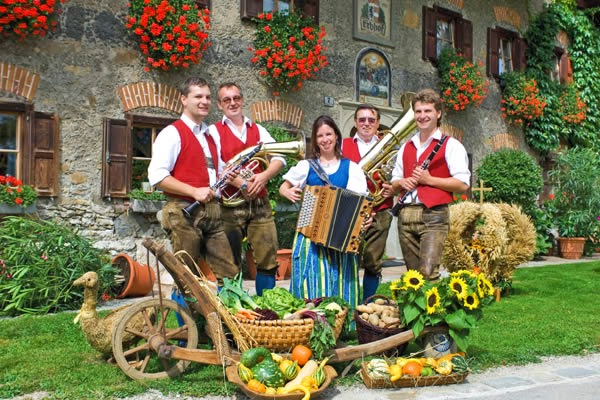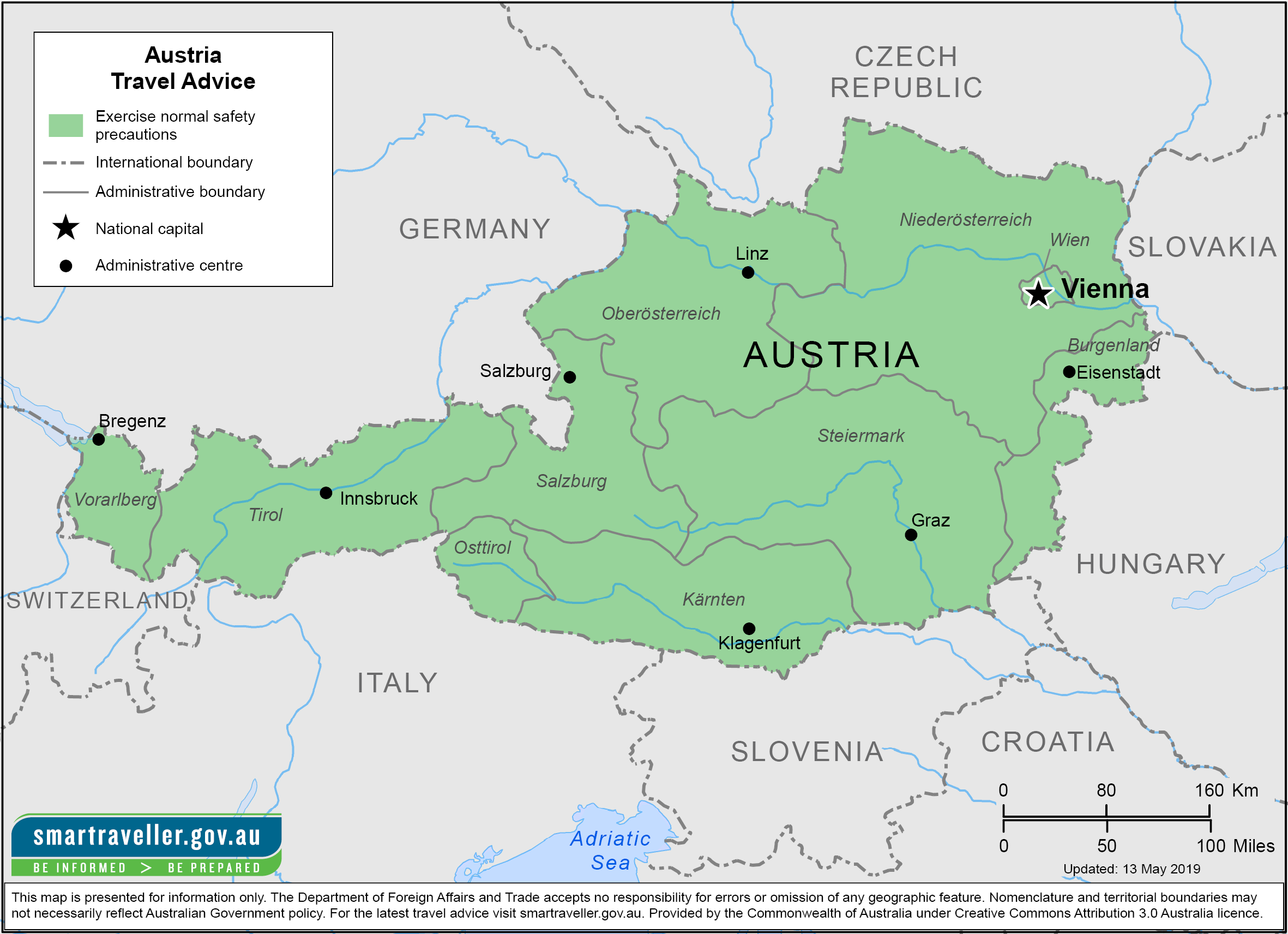Location and Geography. Located in south-central Europe, Austria is a landlocked, mountainous country, with an area of approximately 32,375 square miles (83,850 square kilometers). It shares borders with Germany, the Czech Republic, Slovakia, Hungary, Slovenia, Italy, Switzerland, and Liechtenstein. Its western portion is a narrow strip that extends between Germany and Italy. The Danube River, Austria’s only navigable waterway, flows from southeastern Germany across northern Austria. Areas of major settlement are in the Danube valley and in the lowlands or hills north, east, and south of the Alps.
Demography. The 1998 population count was 8,078,449 (2000 estimate, 8,131,111), about 95 percent of whom were ethnic Austrian. Other numerically significant ethnic groups include Slovenes, Croats, and Czechs. Austria has one of the world’s lowest birthrates, and much of the population is under age twenty-five or over sixty-five. About 65 percent of the population is urban, the largest city by far being Vienna (1.64 million).
Symbolism. The black eagle on the Austrian coat of arms is the national emblem. The civic crown on its head represents Austria’s middle classes; a sickle in its left talon represents its farmers; a hammer in the right, its artisans; and broken silver chains hanging from each talon represent freedom from Nazi German control. The red and white bars of Austria’s national flag adorn its breast. These represent the blood-stained tunic worn by Duke Leopold V of Babenberg after the Battle of Ptolemais in 1191. Austria’s national anthem is “Land of the Mountains, Land on the River.”
LAND AREA: 31,942 sq mi (82,730 sq km); total area: 32,382 sq mi (83,870 sq km)
OTHER LARGE CITIES: Graz, 280,258; Linz, 200,839; Salzburg, 150,938; Innsbruck, 131,009CAPITAL AND LAGEST CITY: Vienna, 1.8 million
NATIONAL NAME: Republik Österreich
CURRENT GOVERNMENT: Federal republic
ETHNICITY/RACE: Austrians 91.1%, former Yugoslavs 4% (includes Croatians, Slovenes, Serbs, Bosniaks), Turks 1.6%, German 0.9%, other or unspecified 2.4% (2001)
NATIONAL HOLIDAY: National Day, October 26
LITERACY RATE: 98%
AREA: 83,858 square kilometers (32,378 square miles)
LANGUAGE:
German is the official language of Austria and an important prerequisite for participating in the working, economic and social life of the country.
Austria is the only country other than Germany where the official language is German, and approximately 98 percent of the population speaks High German or a dialect of it. Austrian German sounds “softer” from that of Germany, and German speakers can easily discern the difference. There are also regional dialects of German, such as Weinerisch, spoken in Vienna. Austria’s Slavic minority, located mostly in the south and the east, speak Slovenian and Croatian as their first language. English is taught in all schools as a second language. Croatian, Slovenian and Hungarian are recognised as official languages of autonomous population groups in some regions.
CURRENCY:
Euro (formerly schilling)
RELIGION:
Roman Catholic 73.6%, Protestant 4.7%, Muslim 4.2%, other 3.5%, unspecified 2%, none 12% (2001 census)
Religious Beliefs. Freedom of religion and worship is guaranteed in Austria. About three-fourths of Austrians are Roman Catholic. Many Austrians practice “baptismal certificate Catholicism,” in which they are Catholic by baptism and religious formality but do not hold Catholic beliefs on central issues. Another major religion in Austria is Protestantism, and many foreign workers are Muslim or Serbian Orthodox. There is also a small community of Jews, mostly post World War II immigrants and their families, although the Jews have a long history in Vienna, beginning in the tenth century.
FOOD AND ECONOMY
Food in Daily Life. Austrian cooking is one of the most varied in Europe and includes German, Hungarian, Czech, and northern Italian influences. A typical Austrian’s day begins with a light breakfast of coffee or milk with bread and butter or jam. Sausage served with mustard on a hard roll is a typical midmorning snack. Lunch is usually the main meal of the day and consists of soup and a main course of meat—sausage, the widely popular Wiener schnitzel (breaded veal), chicken, beef, pork or fish. Fresh vegetables, dumplings, noodles, or potatoes often accompany the main course. A salad may conclude the meal. Austrian city dwellers often take a midafternoon coffee break at a national institution, the coffeehouse. Part of the Austrian way of life, the coffeehouse serves as a meeting place and a source for breakfast or a snack or light lunch. Most coffee-houses, which usually also serve alcohol, have their own distinctive atmosphere. The evening meal usually consists of light fare, perhaps cold meats, cheese, or smoked fish with bread and wine or beer.
Commercial Activities. Austria is highly industrialized, but expert craftsmanship is also valued and can be found in products such as leather goods, pottery, jewelry, woodcarvings, and blown glass. Tourism contributes a substantial portion to the economy, especially ski resorts in the Alps and cultural attractions in Vienna and Salzburg. Agricultural products such as wheat, corn, wine, dairy products, and meat are also produced for sale.
Major Industries. Manufacturing is the strongest sector of the Austrian economy, accounting for one-third of the workforce and about 40 percent of the gross domestic product. Iron ore is Austria’s most important mineral resource, and metal and metal products, especially iron and steel, lead the manufacturing sector. Major products include motor vehicles, locomotives, heavy machinery and equipment, customized electronics, and tools. Other principal manufactured goods include chemicals, petroleum, graphite, wood and paper products, textiles, tobacco products, beverages, and processed foods.
Trade. Germany is Austria’s principal trading partner, with Austria importing crude oil, machinery and equipment, chemical and manufacturing products, pharmaceuticals, and some foods. Austria’s major exports are machinery and equipment, electronics, paper products, clothing and textiles, metals, and transportation equipment. Austria joined the European Union (EU) in 1995. It also conducts wide-ranging foreign trade with Italy, Switzerland, and other EU countries, as well as the United States, Japan, and other Asian countries.
Division of Labor. Craftsmen serve as apprentices for several years before becoming journeymen and, finally, master craftsmen. Farming is done mainly by families who own the land. Immigrants from a number of nations are employed as unskilled labor and service industry workers. Professional, white collar, factory, and government jobs are held mainly by native Austrians.
COMMUNICATIONS: Telephones: main lines in use: 3.342 million (2012); mobile cellular: 13.59 million (2012). Broadcast media: Austria’s public broadcaster, Osterreichischer Rundfunk (ORF), was the main broadcast source until commercial radio and TV service was introduced in the 1990s; cable and satellite TV are available, including German TV stations (2008). Internet hosts: 3.512 million (2012). Internet users: 6.143 million (2011).
TRANSPORT:
Transportation: Railways: total: 6,399 km (3,552 km electrified) (2011). Highways: 124,508 km; (including 1,719 km of expressways) (2012). Waterways: 358 km (2011). Ports and harbors: Enns, Krems, Linz, Vienna. Airports: 52 (2013).
Cars
The Austrians are known to be a car-loving nation. As a result, Austria boasts an excellent road network. However, almost all of the bigger cities suffer from severe parking availability problems. Spaces are scarce and prohibitively expensive. If you do find a space, the time you are allowed to park for is usually around 90 minutes in central districts. One way streets and traffic jams also take enjoyment out of the journey.
If you do decide to drive your own car here to Austria you will need to purchase a Vignette which is a form of toll that allows you to drive on Austria’s motorways. These vignettes can be purchased at gas stations, border crossings etc.
Drivers in Austria are also required to carry safety warning equipment, namely a reflective warning triangle to place on the road in the event of an accident, a first aid kit and a reflective vest. Failure to carry these items in your car will leave you liable to a fine.
Public transport
The public transport system in Austria is excellent. Austria’s rail network is comfortable, reliable and fast. The main rail website offers excellent information on timetables, services and discounts. The quality of service offered by the rail network makes it far more appealing than bus links.
Cities such as Bratislava, Budapest, Prague, Munich, Venice are all are regularly served from main stations. For the more adventurous there is also the possibility to travel further a field to destinations such as Warsaw, Berlin, Kiev etc.
Air links
All of Austria’s major cities including Linz, Salzburg, Innsbruck, Graz and Klagenfurt and Vienna have their own international airports. Austrian Airlines, Austria’s national carrier, serves all of the above cities and connects Austria with many international destinations. There are now a range of low cost carriers which connect Vienna, Linz and Bratislava to a number of European destinations e.g. AirBerlin, FlyNiki, Ryanair, Sky Europe and German Wings.
Public Transport
Most large cities and towns feature some form of public transport, including underground systems, buses, tramlines and suburban railways which means getting around without a car is generally not a problem.
Cycling
Many Austrian cities and towns encourage cyclists through designated cycle lanes. There are many beautifully tended cycling routes throughout the country esp. in areas of natural beauty such as along the Danube river.
CULTURE:

Austrian culture has largely been influenced[citation needed] by its past and present neighbours: Italy, Poland, Germany, Hungary, and Bohemia.
Austria is one of Europe’s foremost cultural destinations, with the glorious musical heritage of Vienna and Salzburg, the contemporary art and architecture of Linz and Graz, and the varied folk traditions of the Alps and the eastern plains.
Vienna is unquestionably one of the great cultural cities of Europe: from the 18th to the early 20th centuries it was the pulsing, multicultural heart of one of the great Empires of the day, and artists, composers, musicians, architects, writers and poets from all over the Habsburg lands gravitated here like moths to a flame. The resulting cultural inheritance includes great palaces such as Schönbrunn, Belvedere and the dour Hofburg, a tradition of fine music dating back to when luminaries such as Strauss, Beethoven, Mozart and Haydn were active and continuing to this day in the colour and pageantry of the Opera Ball and the New Year’s Day Concert, the latter of which is televised around the world. The art galleries of the Kunsthistorisches Museum and the Belvedere rank among Europe’s foremost collections,
A couple of hours further east is Salzburg, which again prides itself on its musical heritage, here centred around one man – Mozart. Although the man himself professed to despise the city and left as soon as he could, his birth there has inspired a great tradition of performance in the city, culminating in the prestigious Salzburg Festival (Salzburger Festspiele). And, lest you forget, you can see the man’s picture applied to chocolates, liqueurs and any amount of tourist paraphernalia.
Bregenz is perhaps not the best known of Austrian destinations, but this small city on the banks of Lake Constance at the extreme western end of Austria has also developed a cultural tradition with its innovative Theatre Festival based around a giant stage floating on the lake.














